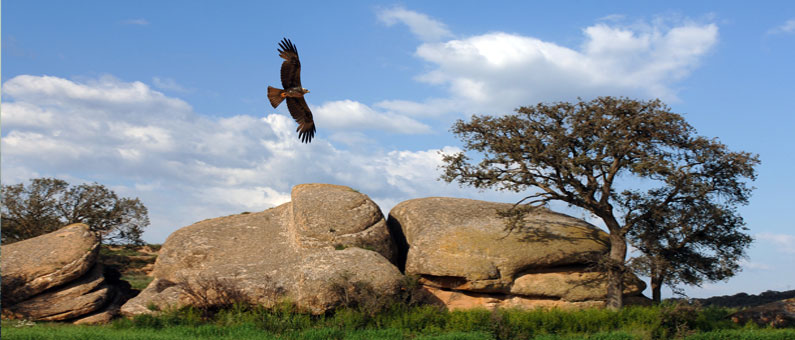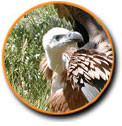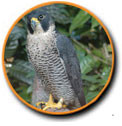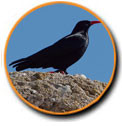
There are two combining factors: on the one hand, the environmental pattern of La Hoya de Huesca offers perfect natural opportunities for birds to make their habitats and, on the other, the protected reserves, such as the ZEPAs (protected areas for birds), six in all. This region is therefore nationally and internationally famous for BIRDWATCHING.
Some of the largest groups of rock birds in the whole of Europe inhabit the limestone gorges of La Hoya. Amongst these there are many birds of prey - the carnivorous variety - recognizable by their curved beak and strong gripping claws.
The most numerous are the Griffon vultures and the bearded vulture, threatened with extinction (incidentally, the only bird on the planet that eats bones). It is here, in one of the few European redoubts, that this bird still exists.
The Guara Sierra and what is known as the Syncline Kingdom are authentic paradises for observing rock birds of prey: the Egyptian vulture (boleta in Aragonese), Griffon vultures, eagles, the bearded vulture already referred to, and other species.
In the sky over the rock formations and gorges in the region you can make out the typical silhouettes of each one of these big birds of prey as they glide with expertise on the air currents.At different points in La Hoya, open air or covered areas have been equipped as excellent observatories to study and enjoy watching these birds. These are in Riglos and in Santa Cilia de Panzano.
ACCES: Foz de Salinas, from Villalangua: Take the sign-boarded path behind the church and go down to the river. This path reaches Agüero crossing the Osqueta (between Salinas de Jaca and Agüero)
 Griffon Vulture
Griffon Vulture
 Red Kite
Red Kite
 Halcon Peregrino
Halcon Peregrino
 Eurasian Eagle Owl
Eurasian Eagle Owl
ACCES: From La Peña, take the sign-boarded pathway.
 Griffon Vulture
Griffon Vulture
ACCES: These ridged cliffs are behind the village.
 Egyptian Vulture
Egyptian Vulture Griffon Vulture
Griffon Vulture Bearded Vulture
Bearded Vulture Red Kite
Red Kite Peregrine Falcon
Peregrine Falcon Eurasian Eagle-Owl
Eurasian Eagle-Owl Red-Billed Chough
Red-Billed Chough
ACCES: Apart from the synclines, there are several areas in Riglos to practise bird-watching:
ARCAZ Interpretation Centre for Birds of Prey: In the town of Riglos. It has a glass look-out to watch the birds and is also equipped with video cameras.
Eagle Lookout: View over the synclines and eagle habitats of Riglos. You can reach it on the path that leaves from the Marcuello Castle. To get onto this path, take the track from Sarsamarcuello, or the path from the village Linás de Marcuello.
At Riglos the building, planned by José Miguel Sancho, fits well into the surroundings and has access for wheel chairs. With over 700 square metres and magnificent country on all sides in the Riglos Synclines, the Arcaz Centre gives information on one of the largest colonies of Griffon vultures in Europe.
The Centre’s resources include different rooms on three storeys, a spacious hall with a reproduction of the synclines and a glass look-out for close observation of the steep cliffs, as well as an auditorium where you can see live pictures broadcast by two video cameras situated near the nests at Arcaz.
 Egyptian Vulture
Egyptian Vulture Griffon Vulture
Griffon Vulture Bearded Vulture
Bearded Vulture Golden Eagle
Golden Eagle Red Kite
Red Kite Peregrine Falcon
Peregrine Falcon Eurasian Eagle-Owl
Eurasian Eagle-Owl Red-Billed Chough
Red-Billed Chough